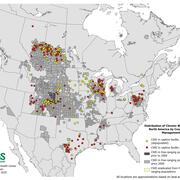Distribution of CWD in Relation to Tribal Lands in the U.S.
Distribution of CWD in Relation to Tribal Lands in the U.S.Distribution of Chronic Wasting Disease in North America, in Relation to Tribal Lands in the Conterminous United States. Updated on April 17, 2025.














